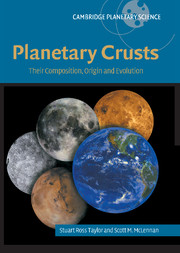Book contents
- Frontmatter
- Contents
- Preface
- Acknowledgments
- List of abbreviations
- Prologue
- 1 The planets: their formation and differentiation
- 2 A primary crust: the highland crust of the Moon
- 3 A secondary crust: the lunar maria
- 4 Mercury
- 5 Mars: early differentiation and planetary composition
- 6 Mars: crustal composition and evolution
- 7 Venus: a twin planet to Earth?
- 8 The oceanic crust of the Earth
- 9 The Hadean crust of the Earth
- 10 The Archean crust of the Earth
- 11 The Post-Archean continental crust
- 12 Composition and evolution of the continental crust
- 13 Crusts on minor bodies
- 14 Reflections: the elusive patterns of planetary crusts
- Indexes
Preface
Published online by Cambridge University Press: 22 October 2009
- Frontmatter
- Contents
- Preface
- Acknowledgments
- List of abbreviations
- Prologue
- 1 The planets: their formation and differentiation
- 2 A primary crust: the highland crust of the Moon
- 3 A secondary crust: the lunar maria
- 4 Mercury
- 5 Mars: early differentiation and planetary composition
- 6 Mars: crustal composition and evolution
- 7 Venus: a twin planet to Earth?
- 8 The oceanic crust of the Earth
- 9 The Hadean crust of the Earth
- 10 The Archean crust of the Earth
- 11 The Post-Archean continental crust
- 12 Composition and evolution of the continental crust
- 13 Crusts on minor bodies
- 14 Reflections: the elusive patterns of planetary crusts
- Indexes
Summary
This work is not intended as a textbook, or as a review, but represents an enquiry into the problem of how and why solid planets produce crusts. As this seems to have happened at many different scales throughout the Solar System, we were curious to see whether some general principles might emerge from the detail. The formation of the planets themselves is the outcome of essentially random processes, constrained mainly by the history of the inner nebula and by the cosmochemical abundances of the chemical elements. But perhaps the production of crusts might be a simpler or more uniform process, a notion supported by the frequent appearance of basaltic lavas of assorted types on the surfaces of rocky bodies.
This book is also written from geochemical and geological perspectives, the areas with which the authors are most familiar. We were immediately faced with the problems of ordering the discussion in a logical sequence because “good reasons could be found for placing every chapter before every other chapter”. Although one might reasonably expect to begin such a book with a discussion of the continental crust on which we are standing, this useful feature, like the Earth itself in a wider planetary context, is one of the least enlightening places from which to discover how planets form crusts. For this reason, our familiar continental crust appears late in the discussion. We decided instead to begin with simpler examples.
- Type
- Chapter
- Information
- Planetary CrustsTheir Composition, Origin and Evolution, pp. xv - xixPublisher: Cambridge University PressPrint publication year: 2008

